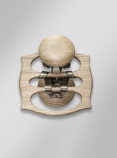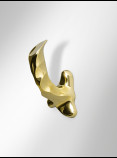The recovery of Gaudí and Modernisme

Coat rack from the Casa Calvet. Antoni Gaudí i Cornet. DB Barcelona Design after 2019 (producer). Barcelona, 1900-1901. 2020 Edition. MDB 12.542. Photo: Estudio Rafael Vargas

Hydraulic tile. Antoni Gaudí i Cornet. Hijo de E. F. Escofet (producer). Barcelona, c. 1906. 1961 Edition. MADB 136.942. Photo: Estudio Rafael Vargas

Door knobs from the Casa Milà. Antoni Gaudí i Cornet. BD Ediciones de Diseño (producer from 1987 to 2007), BD Barcelona Design (productor from 2007). Barcelona, c. 1910. 2020 Edition. MDB 12.532. Photo: Estudio Rafael Vargas
In the years after the Spanish Civil War, the image of Gaudí and the Sagrada Família survived as a possibility of keeping Catalanism alive in a manner tolerated by the Franco regime. In this environment, in 1952, the Friends of Gaudí Association was created, which organized an exhibition at Tinell Hall in 1956, the same date on which the Gaudí Chair of the Graduate School of Architecture was also founded. Later, in 1963 the Gaudí House-Museum was inaugurated at Park Güell.
Gaudí’s international recognition came when MOMA dedicated an exhibition to him in 1957, after overcoming the reluctance of museum directors, who defended the modern spirit. The promoter was Columbia professor Georges R. Collins, founder of Friends of Gaudí USA, who had discovered him at the Tinell exhibition. At the same time, the architect Kenji Imai of Waseda University promoted the Japanese section. In 1967, the book The Sources of Modern Architecture and Design by Nikolaus Pevsner argued that the free and functional forms of Art Nouveau were in the origins of modern design. Such efforts generated the recovery of Art Nouveau and the great figures such as Guimard, Horta, Mackintosh and also Gaudí and Modernisme.



